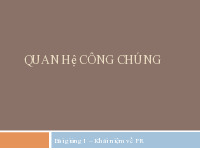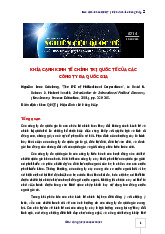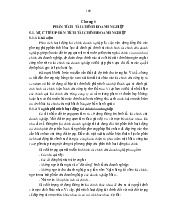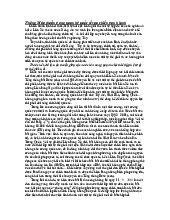



















Preview text:
BEHIND SOUTH KOREAN COSMETIC SURGERY:
ITS HISTORICAL CAUSES AND ITS INTERTWINED RELATIONSHIP WITH KOREAN POP CULTURE by Yuqing Wang
A thesis submitted to the Faculty of the University of Delaware in partial fulfillment of
the requirements for the degree of Master of Arts in Liberal Studies Spring 2015 © 2015 Yuqing Wang All Rights Reserved ProQuest Number: 1596907 All rights reserved INFORMATION TO ALL USERS
The quality of this reproduction is dependent upon the quality of the copy submitted.
In the unlikely event that the author did not send a complete manuscript
and there are missing pages, these will be noted. Also, if material had to be removed,
a note will indicate the deletion. ProQuest 1596907
Published by ProQuest LLC (2015). Copyright of the Dissertation is held by the Author. All rights reserved.
This work is protected against unauthorized copying under Title 17, United States Code
Microform Edition © ProQuest LLC. ProQuest LLC. 789 East Eisenhower Parkway P.O. Box 1346 Ann Arbor, MI 48106 - 1346
BEHIND SOUTH KOREAN COSMETIC SURGERY:
ITS HISTORICAL CAUSES AND ITS INTERTWINED RELATIONSHIP WITH KOREAN POP CULTURE by Yuqing Wang
Approved: _________________________________________________________ D. Heyward Brock, Ph.D.
Professor in charge of thesis on behalf of the Advisory Committee
Approved: _________________________________________________________ Jeffrey L. Richardson, M.A.
Interim Director of the Liberal Studies Program
Approved: _________________________________________________________ George H. Watson, Ph.D.
Dean of the College of Arts and Sciences
Approved: _________________________________________________________ James G. Richards, Ph.D.
Vice Provost for Graduate and Professional Education ACKNOWLEDGMENTS
This thesis represents not only my work at the keyboard; it also represents a
milestone in more than one year semester of research studying at University of Delaware
and specifically within the Liberal Arts program. Throughout this semester, I have
learned writing skills, resource allocating and logical organizing capability of the
contents. Applying these techniques and skills from the classroom, I decided to compose
a thesis that can present the current frenzy of the South Korean cosmetic surgery
industry, tracing its historical sources that generally ignored by the western news reports.
The research was launched with helps and supports from several my liberal arts
professors. First and foremost, I wish to thank my advisor, D. Heyward Brock, the erudite
professor of the English department at UD. He has been supportive since the days I began
working on the outline of the thesis. Ever since, Dr. Brock has supported me not only by
providing research support over a year, but also academically helped me through the road
of composition to finish this thesis.
I would also like to express my gratitude to Dr. Karen Rosenberg, for her wise
feedbacks and knowledgeable suggestions to my thesis. As a renowned anthropologist,
her professional scholar researching style also helped me keep my approach to
composition in check. Her insights towards human evolution and the course of women iii
social development have contributed an incredible amount of improvements to the thesis as well.
A sincere acknowledgement also goes to my graduate thesis committee, who has
provided me with invaluable assistance and direction in assembling the paper with correct
format. Ms. Eileen Burget in particular, took many disparate sections of the thesis into
attentive consideration and informed me with more proper academia fashion. Without her
help, my interest in investigating the cosmetic surgery industry could not be formatted with professional style.
Finally, my sincere thank you goes to Mr. Sean Crowley, who is a professional
cinematographer himself and who has helped me over the thesis topic development.
During the most difficult times when writing this thesis, he gave the instructive guidance
and morale support to continue moving on. iv TABLE OF CONTENTS
LIST OF FIGURES..........................................................................................................vi
ABSTRACT...................................................................................................................viii Chapter
1 INTRODUCTION...................................................................................................1
2 THE POPULARITY OF COSMETIC SURGERY IN SOUTH KOREA..............9
3 HISTORICAL CAUSES.......................................................................................20
Anti-Japanese Nationalism......................................................................20
IMF Financial crisis.................................................................................26
Bankruptcy...............................................................................................28
Massive Layoffs.......................................................................................29 Surgery a Psychological s
Therapy...........................................................32
4 KOREAN POP AND THE COSMETIC SURGERY INDUSTRY......................37
Origin of K-pop.......................................................................................37
K-pop Frenzy...........................................................................................38
K-pop and Cosmetic Clinics....................................................................39
5 THE IMPACT OF KOREAN COSMETIC SURGERY INDUSTRY...................45
Impact I: Medical Tourism to Korea........................................................45
Impact II: Increasing Job Opportunities...................................................48
Impact III: Individual Identity Crisis.......................................................50
Impact IV: Pressure and Younger Generation.........................................54
Impact V: High Risk of Cosmetic Surgery..............................................57
6 CONCLUSION.......................................................................................................63
REFERENCES...........................................................................................................68 v LIST OF FIGURES
Figure 1 Identical Faces....................................................................................................7
Figure 2 Highest Plastic Surgery Rate..............................................................................9
Figure 3 Plastic Procedures per Thousand Population....................................................10
Figure 4 Nation Surgery Ranking....................................................................................12
Figure 5 Facial Surgery Ranking.....................................................................................13
Figure 6 South Korea Cosmetic Surgery Number...........................................................14
Figure 7 The Number of Medical Tourists to South Korea.............................................15
Figure 8 Gangnam District..............................................................................................17
Figure 9 Clustered Surgery Clinics.................................................................................18
Figure 10 Double Eyelid Surgery Patients......................................................................24
Figure 11 The Close-Up image of Eyelid Surgery..........................................................24
Figure 12 Macro Economic Indicators in Korea.............................................................27
Figure 13 Financial Conditions of Korean Chaebol........................................................28
Figure 14 Sample Korean Resume..................................................................................31
Figure 15 Auspicious Eye Shape.....................................................................................34
Figure 16 Before and After Surgery: Actress Kim Nam Joo..........................................39
Figure 17 Before and After Surgery: Park Min Young...................................................40
Figure 18 Before and After Surgery: Kwon Yuri............................................................40
Figure 19 Cosmetic Surgery Advertisements Everywhere..............................................42
Figure 20 Subway is the hub of clinic advertisements....................................................42
Figure 21 Facial Contouring Products.............................................................................44
Figure 22 Face Transformation Magic............................................................................46
Figure 23 Drastic Transformation...................................................................................51
Figure 24 Face Transformation.......................................................................................52
Figure 25 Miss Korea Candidates of 2013......................................................................53
Figure 26 The Offspring and Parents...............................................................................57 vi
Figure 27 Commonly-seen Post-surgery Patients...........................................................59
Figure 28 Patient Wrapped in Bandage After Facial Surgery.........................................60
Figure 29 Jaw Shaving Process...…......…............…....……......…................................61 vii ABSTRACT
This thesis focuses on South Korea’s cosmetic surgery industry. Its discussion
covers three aspects: cause of the fast booming cosmetic surgery practices in South
Korea; Korean Pop culture as a live advertisement promoting surgery clinics and
pressuring more people to undergo cosmetic surgery; and the impact of cosmetic surgery
on South Korean society and economics. The thesis challenges some interpretations on
Korean cosmetic surgery that western media reports put forward. Many of these reports
outline how influenced Koreans are by the “western standards” of beauty and, therefore,
are trying to “look more western” through surgery (Kyung Lah, CNN.com). This thesis
argues that the reasons that account for the Korean surgery boom can be traced to a set of
more complicated factors, both historical and cultural. These factors gave birth to
aesthetic surgery practice, while Korean Pop culture and stars largely encouraged the
continued expansion and growth of the Korean cosmetic surgery industry. Jointly, these
two forces together have made South Korea the most surgically-enhanced nation on the
planet. In conclusion, the thesis examines the impact of such pervasive beauty surgery practices in South Korea.
Keywords: South Korea, Cosmetic Surgery, Beauty, K-pop viii Chapter 1 INTRODUCTION
Based on Dorland’s Medical Dictionary, cosmetic surgery is one type of
operational surgery under the umbrella of reconstructive surgery. Reconstructive surgery
refers to medical operations on facial and body defects, which might be caused by birth
deficiencies, accidents, burns or diseases. Reconstructive surgery is, therefore, intended
to correct certain dysfunctional areas of the body. Cosmetic surgery, in particular, is an
elective treatment, as the treated areas can perform normal biological tasks but simply
lack of aesthetic appeal, or at least deemed by the patient him or herself to be unappealing.
In South Korea, it is reported by the ISAPS (International Society of Aesthetic
Plastic Surgeons, isaps.org) that nearly 15 million cosmetic surgery procedures were
done in 2011 South Korea is, therefore, considered to be the country with the largest
cosmetic-enhanced population in the world. Korean aesthetic surgery clinics also reached
to an unprecedented scale beyond other countries, with hundreds of clinics clustered in
the Apgujeong-Gangnam area alone, which it is known as the Korean “Beauty Belt”.
This thesis analyzes the causes behind the booming cosmetic surgery treatments in South
Korea national wide, and examines the relationship between cosmetic surgery’s
popularizing and K-pop culture. In this context, the thesis concentrates on South Korea
particularly with no regards to other countries such as the U.S., Thailand, or Brazil, 1
which are also known for their copious use of aesthetic surgery. Nor does the thesis
separately discuss the booming male cosmetic surger 1 y in South Korea.
My interest in Korean cosmetic surgery was sparked during my learning K-pop
dance. Watching K-pop dance MVs and tutorials brought me to a further exposure to the
Korean entertainment industry. The ubiquitous perfect facial features, i.e. big eyes, white
skin, high-bridged noses, and sharp V-shaped chins, that almost every celebrity possesses
triggered me to wonder: “how could all these people look so perfect but so similar?”
Bearing in mind with this question, I started my researches on South Korea beauty
culture and found startling statistics on Korean cosmetic surgery practices. For instance,
SBS Dateline journalist Jeannette Francis reported that, “on a single street that extends
for less than a mile in Gangnam district, there are at least 300 plastic surgery clinics”
(Francis, SBS Dateline). Such obsession with cosmetic surgery in Korea has invited an
array of attention, discussions and debates from news media and academic scholars. Yet a
large number of media reports attribute Koreans’ craze for beauty to its pursuit of
Caucasian features (Lah, CNN.com). For example, one CNN news remarks:
The Chinese and Korean patients are seeking to have a westernized face, high
profile nose, slender nice cheekbone and mandible bone. Another CNN report proclaims:
1 In Gender, Globalization and Cosmetic Surgery in South Korea by Ruth Hol iday and Jo Elfving Hwang,
the research reveals that an increasing practice of cosmetic surgery in male population is emerging in the country. 2
The majority of facial cosmetic operations performed on Asians are considered
"Westernizing" procedures. Two of the most popular, nose jobs (rhinoplasty) and
eyelid lifts (blepharoplasty), are specially designed to make these features look
more Caucasian (Youn, CNN.com). ABC news states:
Double eye-lid surgery gives Asian mono-lids a ‘Hollywood look’, and a raised
nose bridge is considered as an elegant Western trait (Chang, Thompson, ABC News).
Eating Disorders’ author, Christine Iijima Hall, also comments that “the facial
characteristics of the epicanthic eye fold, a ‘flat’ nose, and a broad nose bridge are
common among Asians. Many Asian women desire to have the double eyelid and the
‘sculptured nose’ like westerners, so much so that they spend much time and money to
adapt their features to such a standard” (Hall, “Asian Eyes”, 12).
This thesis contends against the above remarks. It argues against the claim made by
media reports from non-Asian countries that Korea’s surgery frantic is caused by the
“desire to look more like western Caucasians.” Certainly, such media observations hold
some validity to the shift of Asian cultural perception of beauty that may be influenced
by western fashion. Yet, there is an underlying view conveyed by ideas that western 3
countries are the ones holding the definition of standard beauty and that Koreans are
imitating Caucasian facial features.
Nobody is able to define beauty in a homogeneous way, nor is western
appearance what Koreans aspire to model and that can drive them to enter into clinics in
such large numbers. This thesis argues that an outside interpretation of Koreans’ desire
to achieve a more “western look” is not one of the fundamental factors fueling the plastic
surgery boom in South Korea. As Ruth Holliday and Jo Elfving Hwang have stated, such
a claim lacks the in-depth understanding of the factors brought up by contemporary Korean societal development:
Existing research on cosmetic surgery in Korea frames cosmetic surgery […] as
an undesired effort of Western cultural influence…However, this research
questions these simplistic explanations. We will show that the meanings and
practices of aesthetic surgery represent a process of negotiation between multiple
discourses concerning national identity, globalized and regionalized standards of
beauty, as well as the symbolic practices of coming of age, marking of social
status and seeking success and peer recognition (Gender, Globalization and Aesthetic Surgery, 2).
With that being said, to try to model oneself after Caucasian traits could hardly
lead to an entire district in Seoul to be clustered with surgery clinics, nor would it make
one in five Korean women undergo some type of surgical procedure 4
(asiancenturyinstitute.com). It would not be sufficient reason for vast numbers of parents
to bring their teenage daughters for the high-risk, painful medical procedures such as
nose augmenting, eye enlarging or jaw shaving/sharpening. Henceforth, this thesis argues
that the claim that “westernization” is what have accounted for Koreans’ pursuing plastic
surgery overlooks certain important historical and societal causes that have contributed to
the rise of the cosmetic surgery obsession in South Korea.
This thesis argues that Korean cosmetic surgery is a commercial product
generated through some combined historical and economic factors: Japanese colonization
in between 1910 and 1945, Asian Financial Crisis, competition-led lookism culture and
encroaching K-pop media advertising. This thesis contends that these historical and
economic components are what brought cosmetic surgery into existence; meanwhile K-
pop culture and media advertising are what stimulates the continued expansion of the cosmetic surgery industry.
First, Japan’s colonial rule in Korea ignited Koreans’ resentment against Japan.
Such resentment triggered the formation of Korean nationalism. Koreans, therefore, are
eager to differentiate themselves from other Asians, especially the Japanese ethnicity.
Korean stated that their body features are superior to the Japanese and their looks far
from typical Asian traits. Second, the Asian Financial Crisis, which heavily injured
Korean employment in 1990s, brought even more fierce competition among job seekers.
With heavy layoff rates and fewer job openings, the employment market began to also
include appearance as one of the selective conditions for hiring a candidate. This practice, 5
which is still in existence today in the country, requires the applied candidates to attach
professional headshot photos at the top corner of the job application form (jezebel.com).
It is generally considered that attractive-looking people are intelligent, respectable, and
higher in social status, who are, therefore, more likely to be selected through the
interview and to gain more favor from employers.
Two facts about Korean cosmetic surgery distinguish it from other countries. One
is how ‘cosmetic surgery’ is termed in Korean. The Korean work for “cosmetic surgery” is Seonghyeong, or
성형, of which the meaning can only be translated as “reform”
surgery. Such a way of referring to cosmetic surgery is quite different from western
countries, implying Koreans’ unique perspective towards the procedure: the word
“reform”, exerting positive connotations, and is considered a “rebirth of a new life” and
makes the individual “transform to be more beautiful” (eatyourkimchi.com).
Comparatively, “cosmetic” or “plastic” surgery is considered to have a negative
connotation as “man-made” or “artificial”. This point will be further illustrated in
Chapter 3, The Historical Causes under Lookism-Drive Society .
The other fact is that cosmetic surgery is not done as an enhancement of the
patient’s original facial features. Instead, the surgery is dedicated to reshape patients’
features to a set form of beauty standards, which are accepted by the cultural-societal
perception of beauty. As shown in Figure 1, cosmetic surgery in Korea is more towards
molding many women look alike-- all have V-Shape chins, double eyelids, big eyes, and 6
two plump under-eye belts, which add an innocent, childlike smiling-eye look to the individual. Figure 1 Identical Faces
Source from: http://www.allkpop.com/forums/discussion/183269/what-s-the-ideal- korean-look
This thesis thus consists of four thematic sections: (1) popularity—how
widespread is cosmetic surgery practice in South Korea; (2) causes the — history and
social evolvement attributes that led to the birth of cosmetic surgery; (3) expansion—
Korean pop culture and its function as celebrity-endorsed advertisements for Korean
plastic surgery clinics; (4) impact the —
influence of cosmetic surgery to Korean
teenagers, Korean tourism, and its national economy. Based on the thematic sections, the
study is divided into six chapters. The first introduction chapter concentrates on the 7
purpose of the thesis, debunking the misinterpretations of Korean plastic surgery and
establishing the thesis structure. Chapter 2 presents statistics to answer exactly how
popular cosmetic surgery is in Korea. Chapter 3 begins with a brief synopsis of Korean
history in order to discuss the historical, economic and social reasons that brought
cosmetic surgery into existence. Chapter 4 connects K-pop culture with its cosmetic
surgery epidemic to argue that K-pop is a powerful advertising vehicle for surgery clinics
to allure the global audience into this beauty capital for surgery operations. Chapter 5
analyzes the impact of the Korean cosmetic surgery boom. It argues that its cosmetic
surgery industry brings in large international medical tourists, generating lucrative profits
for the Korean national economy. This section also discusses that the pressure of
appearance compels younger and younger Koreans to step into operation room in order to
look as beautiful as the stars. Chapter 6 summarizes the key arguments in the thesis and
points to further research areas and readings that could be explored by readers. 8 Chapter 2
THE POPULARITY OF COSMETIC SURGERY IN SOUTH KOREA
After the release of “ISAPS International Survey on Cosmetic Procedures
Performed in 2009”, South Korea is ranked as the number one country with the highest
ratio of overall aesthetic surgical procedures in per ten thousand people (PP10K) of all ages per year (
), as shown in Figure 2 and 3. isaps.org
Figure 2 Highest Plastic Surgery Rate
Source from http://www.asianplasticsurgeryguide.com/news10-2/081003_south-korea- highest.html 9
Figure 3 Plastic Procedures per Thousand
Source from: http://www.economist.com/blogs/graphicdetail/2012/04/daily-chart-13 10
Korea, reported to have 365,000 total procedures, has turned out to boast 74 procedures
PP10K in 2010, 1.8 times higher than the number in the United States, which is PP10K of
42 (asianplasticsurgeryguide).
In addition, Seoul Touchup published a series of graphs that combined its own findings
with statistics released by ISAPS survey in 2011, as shown below: 11




